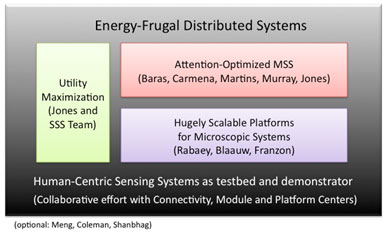
Team and Organization
Motivation: While the "Large-Scale Systems" theme address the
energy-smart systems spanning large areas, this theme concentrates on the
opposite corner of the distributed system spectrum. It explores the
opportunity of developing sensing systems that zoom in to the microscopic
level. It is only in the last couple of years that the semiconductor and
IT industries (taking the lead from the defense community) started to
realize the business potential of so-called "cyber-physical" systems,
which provide the interface between the physical, human and the
computational worlds. Potentially consisting of trillions of wireless
sensor nodes distributed in the environment, these systems address
large-scale problems such as security, defense, environment, energy,
disaster management, health, and generally quality of life. While major
progress was made over the past decade, a broad range of true
opportunities is still out of reach. Reducing energy dissipation and size
of the wireless sensory systems by even one or two orders of magnitude
would open the door for some large-impact applications such as
intelligent materials or surfaces, smart objects that are aware and
adjust to their surrounding conditions (think about intelligent car
tires, for instance), and enriched human sensory and monitoring interface
systems (enabled by either body-area or implanted networks). The prospect
of ubiquitous sensing at all scales on the battlefield could also
revolutionize military capabilities and systems. For instance, personal
sensor networks may extend and improve the sensory field of individual
soldiers. Microscopic sensing systems present by far the greatest
opportunity for new markets and growth in the semiconductor industry, as
they open potential markets for literally trillions of circuits - but
only if orders of magnitude reduction in energy dissipation and size
beyond current systems is achieved.
Energy is indeed THE overriding concern in the design and deployment for
these microscopic systems. In contrast to the large-scale systems, they
must be "energy-frugal". While some nodes may carry batteries, others
must be totally energy self-contained (a single battery charge must
suffice for the life-time of the project, or the node must replenish its
energy reservoir through scavenging). For example, current "personal"
surveillance and environment-awareness systems (as carried by soldiers in
the field) come with a prohibitive battery load which now approaches 20
lbs or more for typical missions; increasing the capability and
performance of the electronic systems available to the individual soldier
now depends first and foremost on radical improvements in energy
efficiency of small-scale systems.
Vision: Simple solutions to the energy and related challenges are
not in sight. The International Technology Roadmap for Semiconductors
states that for SOC consumer portable chips "simply extrapolating from
current state of the art technology
the resulting power consumption
substantially exceeds the requirements". Moore's Law or
business-as-usual will not come to the rescue and enable game-changing
microscopic systems. Fundamental new approaches are needed. They require
the adoption of truly innovative technologies in terms of sensing, data
processing, communication and energy harvesting, all integrated using
aggressive heterogeneous packaging strategies. Yet as in the large
systems space, the true opportunities lie in a holistic system vision. A
distributed energy-driven management strategy, adaptively selecting the
right information, data resolution and rate, signal representation,
communication bandwidth, and data latency over a broad dynamic range can
help to provide the desired functionality at an absolute minimal energy
cost. Plenty of inspiration for such "attention-optimized" multi-scale
systems can be found in the biological world. The unified multi-scale
system design strategies, advocated in this proposal, are hence an
instrumental part of the solution; there is simply no other place to turn
for the needed improvements.
The small-scale system theme of MuSyC is hence built on a dual
foundation. Overlaying it is a distributed multi-scale dynamic run-time
environment, operating over many layered abstractions and merging
sensing, computing, control and actuation (as advocated in the SCS
Theme), inspired by meaningful systems metrics (utility). The actual
realization of this environment requires an implementation platform that
fully supports the concept of attention-optimization over a broad dynamic
range, while being extremely energy-frugal at the same time. The
multi-scale aspect of the small-scale system theme primarily is in the
combination of multi-layered abstractions, combined with the
heterogeneous integration of electronic, mechanical, chemical and
biological components into a single entity. Its innovative agenda is to
explore the absolute bounds of energy-efficiency and miniaturization by
simultaneous and dynamic exploration of the system, architecture,
platform and technology layers. It is most plausible that ideas emerging
from this arena will ultimately impact computation and communication at
the larger scales as well. The exciting area of biological interfaces to
support personal-area sensory enhancement (including brain-machine
interfaces or BMI) has been chosen as the application driver for this
theme (in synergy with activities at the Platform, Module, and
Connectivity centers).
|